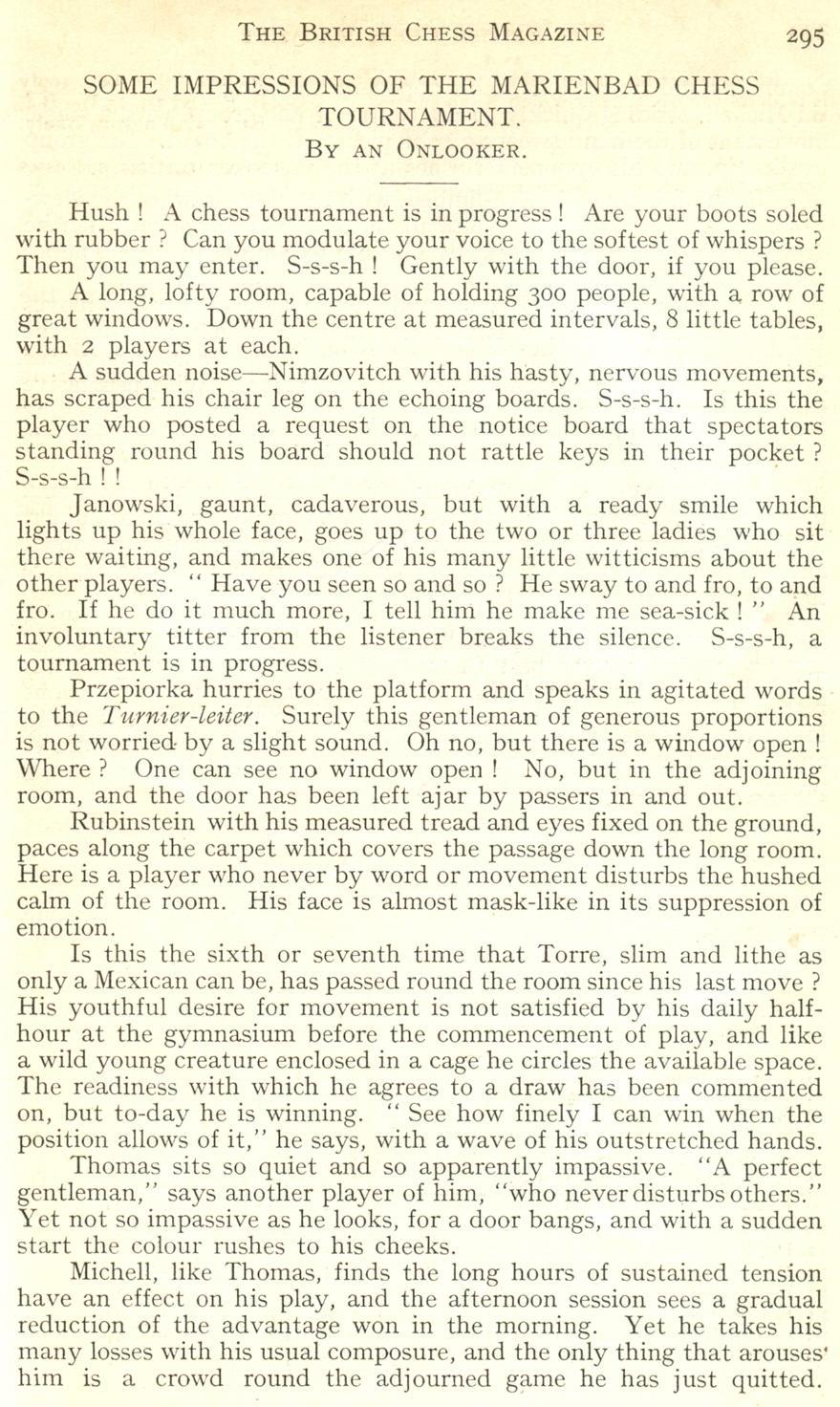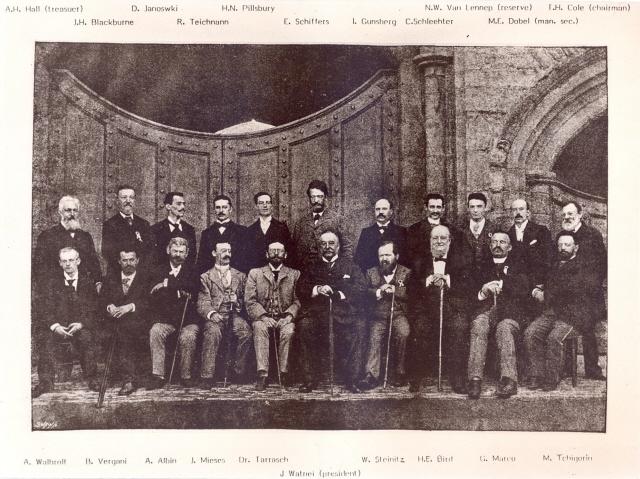

Edward Winter
In former times it was common to read eloquent vignettes which strove to encapsulate, usually without caricature, the chief physical traits and mannerisms of chess masters, but, as we commented in C.N. 2637, ‘The pen-portrait is a form of chess reporting that has fallen into desuetude (as has the word desuetude)’. That item quoted some passages by ‘André de M.’ regarding the London, 1899 tournament from pages 210-213 of La Stratégie, 15 July 1899. For example, in our translation from the French:
‘It would, I think, be difficult to imagine two men more completely dissimilar than Lasker and Janowsky. Nothing disturbs Lasker; his shirt, his clothes are the least of his worries. He is hungry; he goes to the sideboard and returns with a bread roll, which he eats with gusto while continuing his game. His legs are in his way; he puts them over one of the arms of his chair and continues to play, smoking strong cigars; when he reflects deeply he blows the smoke through his moustache with a characteristic grimace.
Janowsky, by contrast, is correctness personified. Seated before his board, he remains almost totally immobile. With a dazzling shirt, Turkish cigarettes, ice-cold lemon-squash, which he sucks through a straw, he is a refined, sensitive player par excellence, a sybaritic player who may lose merely because of a rose-leaf being crumpled.
Pillsbury is a slim young man with lively, intelligent eyes, and a pale, clean-shaven face which has a sad, resigned air, as if chess were an extremely painful task for him.’
Further descriptions of the contestants in London, 1899 may be found in the American Chess Magazine, July 1899, page 10 and September 1899, page 116. One brief excerpt:
‘A real son of Anak is Maróczy, the Hungarian. He must be at least six feet three inches, and as he is tall so is he thin – a perfect lath, but hard as nails. The toughest game leaves him fresh, not a hair turned.’
C.N. 5696 quoted some pen-portraits concerning New York, 1889, from page 5 of the New York Times, 26 March 1889. The first three paragraphs are given below by way of illustration:
‘Most of the players have very well developed craniums, and most of them smoke, but they seem to differ in temperament and in the quality of liquids which they imbibe. Blackburne is about 50 years old, of a rather florid complexion, and deliberate in his movements. He is fond of smoking a short briarwood pipe, crossing his legs, and quietly waiting for his antagonist to rack his brains over the next move. His opponent was Mr Hanham, a nervous little gentleman of about the same age, who hardly ever takes his eyes from the chess board. As the game progresses color mounts to his face and fire in his eye.
Both Gunsberg and Burn are Englishmen, and are said to be well matched. Gunsberg is a blonde, with very deliberate movements and a habit of looking out of the corner of his eye at his opponent when he moves a piece, as though he expected to trip him up. Burn pulls his hat over his eyes with a “you-can’t-catch-me” expression as he deliberates, and not unfrequently changes an attack into a defense. Gunsberg sips seltzer, and Burn puffs away at a cigar.
Chigorin is a rather slender Russian, with black hair and dark complexion. His face is lighted up by thoughtful and large light-blue eyes. He is nervous in his manner, and, as the play proceeds, becomes more nervous, perhaps from drinking a large cup of strong coffee and smoking a cigar. He watches the game intently and deliberates long before making a move, when he sometimes gets up, stretches himself, and goes to another table, where he watches the game for a couple of minutes. His opponent, Delmar, is very well known to chessplayers in New York. He, also, is a coffee drinker and smoker, and is just as deliberate as Chigorin in his calculations and movements.’
A correspondent, Stephen Davies (Kallista, Australia), pointed out in C.N. 5710 that further descriptions appeared on page 8 of the New York Times, 16 June 1889. We pick out here the paragraph about Gunsberg:
‘... Isidor Gunsberg was brought up in London, and has the appearance of an Englishman. His hair is very light, and he is slightly bald on the top of his head. A little below the medium height, he is not slender. His eyes are weak and trouble him a little. In his movements and conversation he is deliberate, his chess training having probably disciplined him to be guarded in everything he undertakes. Unlike the other players, he neither smokes nor drinks, because both vices disagree with him. The only beverages he indulges in besides water are vichy and tea. ... If he refuses the offer of a draw he does so without any bluster, for he is modest and gentlemanly. When he wins, he nods, and smiles at his defeated antagonist.’
Decades later, the pen-portrait was still going strong. The following comes from pages 295-296 of the July 1925 BCM:


It may naturally be suggested that as photography and film became more widespread there was less call for the pen-portrait. On the other hand, such writing requires uncommon powers of observation and expressiveness, with sentences carefully honed and not simply dashed off in the manner of so much ‘chess writing’ nowadays.
The above article originally appeared at ChessBase.com.

C.N.s 4663, 5832, 5836, 5841 and 7354 discussed this photograph, which was taken at the entrance to Battle Abbey.
Below is an article about the masters’ excursion to Battle, published on pages 258-260 of the 4 September 1895 issue of the Chess Player’s Chronicle. The original source is given as the Birmingham Gazette, and the prose style of R.J. Buckley is recognizable.



(7879)
Pen-portraits of, principally, Chigorin, Steinitz and Lasker (at Hastings, 1895) were published on pages 242-243 of the Chess Player’s Chronicle, 21 August 1895. The source specified at the end was ‘A.K.S. in The News’.

Daily Mail, 7 August 1922, page 6
(8193)
To the Chess Notes main page.
To the Archives for other feature articles.
Copyright: Edward Winter. All rights reserved.